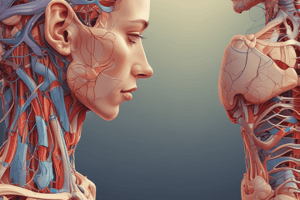Podcast
Questions and Answers
Follicles are sweat gland openings.
Follicles are sweat gland openings.
False (B)
Evaporation causes transepidermal water loss.
Evaporation causes transepidermal water loss.
True (A)
The average pH of the acid mantle is 2.5.
The average pH of the acid mantle is 2.5.
False (B)
Oil comprises about 50 to 70 percent of the skin.
Oil comprises about 50 to 70 percent of the skin.
What provides protection for the epidermis from external factors and lubricates the skin?
What provides protection for the epidermis from external factors and lubricates the skin?
The body perspires to protect us from overheating.
The body perspires to protect us from overheating.
Proteins and peptides trigger the intercellular matrix and cells to rejuvenate.
Proteins and peptides trigger the intercellular matrix and cells to rejuvenate.
Protein and peptides trigger fibroblasts and cells to rejuvenate.
Protein and peptides trigger fibroblasts and cells to rejuvenate.
The six primary functions of the skin include protection, sensation, heat regulation, excretion, secretion, and absorption.
The six primary functions of the skin include protection, sensation, heat regulation, excretion, secretion, and absorption.
What is the integumentary system?
What is the integumentary system?
What are amino acids?
What are amino acids?
What is hydrolipidic?
What is hydrolipidic?
What is the barrier function?
What is the barrier function?
What is transepidermal water loss?
What is transepidermal water loss?
What is the intercellular matrix?
What is the intercellular matrix?
What part of the epidermis is known as the clear cells?
What part of the epidermis is known as the clear cells?
What epidermal layer is composed of a single layer of basal cells?
What epidermal layer is composed of a single layer of basal cells?
What component of the dermis is involved in allergic reactions?
What component of the dermis is involved in allergic reactions?
What part of the skin gives contour and smoothness to the body?
What part of the skin gives contour and smoothness to the body?
What substance in the skin provides protection from the sun?
What substance in the skin provides protection from the sun?
What is the bottom layer of the epidermis?
What is the bottom layer of the epidermis?
What layer of the skin is known as the grainy cells?
What layer of the skin is known as the grainy cells?
What stimulates melanin production?
What stimulates melanin production?
What color is eumelanin?
What color is eumelanin?
Where in the body is hyaluronic acid found?
Where in the body is hyaluronic acid found?
What is the common name for the stratum germinativum?
What is the common name for the stratum germinativum?
What forms the cells in the stratum granulosum that resemble granules?
What forms the cells in the stratum granulosum that resemble granules?
What is another name for subcutis tissue?
What is another name for subcutis tissue?
Flashcards are hidden until you start studying
Study Notes
Functions of the Skin
- Follicles are tubelike structures in the skin associated with sebaceous (oil) glands.
- Transepidermal water loss (TEWL) is the loss of water through evaporation from the skin's surface, crucial for maintaining moisture levels.
- The acid mantle of the skin has an average pH of 5.5, providing a protective acidic barrier.
- Skin is composed of approximately 50 to 70 percent water, essential for hydration and various cellular functions.
Skin Composition and Functions
- Sebum, not lymph, is the oil that lubricates the skin and protects the epidermis from external factors.
- The body regulates temperature through mechanisms such as evaporation, perspiration, radiation, and insulation.
- Proteins and peptides, particularly from fibroblasts, play a vital role in the rejuvenation of skin cells.
Primary Functions of the Skin
- Six primary functions include protection, sensation, heat regulation, excretion, secretion, and absorption. These functions are essential for overall body homeostasis.
- The integumentary system consists of skin layers, nerves, cellular functions, hair follicles, and glands, all regulated by hormones and growth factors.
Biological Molecules and Structures
- Amino acids are the fundamental building blocks of proteins, crucial for skin health.
- The hydrolipidic film maintains the oil-water balance necessary for skin protection.
- The barrier function of the skin protects against irritation and dehydration through the stratum corneum and intercellular matrix.
Skin Layers and Components
- Transepidermal water loss abbreviated as TEWL, indicates the importance of maintaining skin hydration.
- The intercellular matrix consists of lipid substances that safeguard skin cells from dehydration and irritation.
- The stratum lucidum, a clear layer of dead skin cells, allows light to penetrate.
Specific Layers and Their Properties
- The stratum germinativum is the deepest layer of the epidermis, consisting of basal cells that continually regenerate.
- Mast cells located in the dermis play a key role in allergic reactions.
- Subcutaneous tissue, primarily made of fat, provides cushioning, contour, and energy reserves.
Pigmentation and Protection
- Melanin, produced in response to sunlight, protects skin from ultraviolet (UV) radiation.
- The bottom layer of the epidermis, known as the stratum germinativum, is where new skin cells are formed.
- The stratum granulosum, known for its grainy texture, contains keratin-forming cells.
Additional Details
- Eumelanin provides dark brown to black pigmentation.
- Hyaluronic acid, a vital hydrating fluid, is predominantly found in the skin, contributing to moisture retention.
- Adipose tissue is another name for subcutis tissue, important for insulation and energy storage.
Cellular Structures
- Keratin is responsible for the granule-like appearance of cells in the stratum granulosum.
- Exposure to sunlight significantly stimulates melanin production, enhancing UV protection for the skin.
Studying That Suits You
Use AI to generate personalized quizzes and flashcards to suit your learning preferences.




